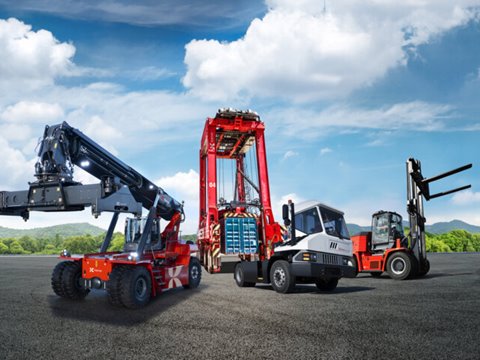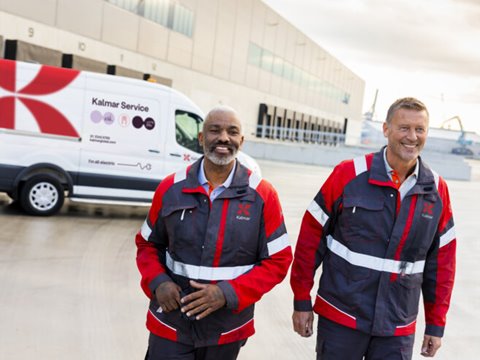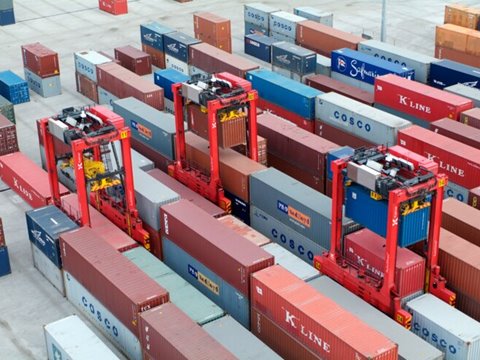
Myth #4: Electric Straddle Carriers are unsafe for maintenance personnel and operators
The concept of using high-powered lithium-ion batteries to power heavy container handling equipment has raised some discussion on the potential fire safety hazards of the technology. Are fully battery-powered straddle carriers less safe than their traditional diesel-electric or hybrid counterparts? Or are they actually safer?
"As with many of the other myths surrounding electric straddle carriers, the best way to look at this is to evaluate the track record of the machinery that is already out there," says Timo Alho, Director, Product Management & Business Development, Kalmar. "We have been delivering High Power batteries for our hybrid straddle carriers for over ten years, and these machines have cumulatively racked up close to 3,000,000 operating hours. Over this time, there have been exactly zero battery fires or other safety incidents due to battery module failure on our hybrid straddles."
We have been delivering High Power batteries for our hybrid straddle carriers for over ten years, and these machines have cumulatively racked up close to 3,000,000 operating hours
The battery technology used in Kalmar straddle carriers is also extremely safe in that the charging and discharging of the battery is monitored and controlled by the energy management system of the vehicle, eliminating the possibility of battery damage or failure due to user error or misuse.
"In addition to being based on field-proven battery technology, Kalmar's electric straddle carriers benefit from having a single company as the integrator for the battery systems," says Aki Heikkinen, Sales Development Lead, AMEA Horizontal Transportation, Kalmar. "We don't outsource our electrical systems to a third party, but design and build everything in-house. This also means that we don't delegate the responsibility for ensuring the safety of our machines."
We don't outsource our electrical systems to a third party, but design and build everything in-house. This also means that we don't delegate the responsibility for ensuring the safety of our machines
Proven power
As for electrical safety in maintenance activities, Timo Alho points out that nearly all straddle carriers currently operating already incorporate electrical drive systems. "This has been standard technology for technicians ever since the transition from diesel-hydraulic to electrical drive. In reality, straddle carriers have already been 'electric' for the last two decades, and the replacement of the diesel engine with a battery really does not create any additional safety issues. Instead, it actually further improves the safety of the machine and its users."
"The service technicians doing electrical work on straddle carriers have already been required to have the appropriate training and certifications," adds Sami Yli-Äyhö, Senior Manager, Product Management Horizontal Transportation, Kalmar. "With the latest generation of equipment, the only difference is that they need to be qualified to handle the High Power and High Energy battery systems on the machines, as well as the chosen charging solution."
As an additional safety policy, the batteries for Kalmar electric straddle carriers are not sold as spare parts. "The batteries need to be kept at the optimum state of charge when in storage, so as part of our safety pledge to our customers, we want to retain the responsibility for the correct storage of the batteries until installation," says Aki Heikkinen. "However, even with a product base of close to 700 hybrid strads operating around the world, the sale of batteries as spare parts has turned out to be a somewhat disappointing business concept, as they basically don't fail!"
Goodbye to diesel
As discussed in previous parts of this article series, the elimination of the diesel powerplant from the machine simplifies the maintenance of a straddle carrier considerably. With fewer regular service points, the occupational safety of maintenance technicians is improved as there is less need to climb on the machine for inspections or the replacement of engine filters or other components. The removal of the internal combustion engine from the machine also largely reduces exposure to emissions and engine noise.
"From both a safety and environmental point of view, it's an undeniable benefit that we no longer need engine oil and diesel fuel in the machine," notes Sami Yli-Äyhö. "The battery pack itself is practically maintenance-free for the service life of the machine, requiring only some coolant changes and scheduled checks."
From both a safety and environmental point of view, it's an undeniable benefit that we no longer need engine oil and diesel fuel in the machine
Up to speed
Finally, in addition to focusing on safe machine design and enhanced safety features, Kalmar takes pride in ensuring that customers, equipment operators and maintenance staff receive the best training in the industry for their equipment.
"In every delivery, we always provide the customer with the training that they need, and this is no different for our battery-powered machines," Aki Heikkinen says. "For new customers and new models, our basic product training is four days, and we always do the training ourselves. So customers can be sure they also receive the best and most up-to-date operating, maintenance and safety guidance for all of their products, literally directly from the factory."
In every delivery, we always provide the customer with the training that they need, and this is no different for our battery-powered machines
Next up is the final part of this series, where we address one of the most widespread misconception about the battery capacity of a straddle carrier - the bigger the better? Right?
Related articles
Further reading
Subscribe and receive updates in your email
Assine nossas publicações

